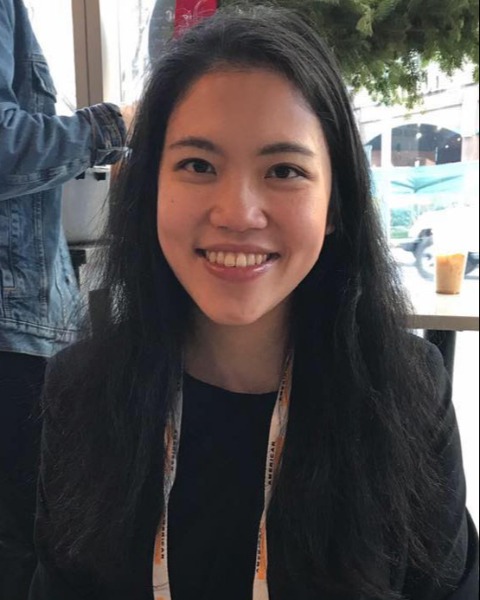Cancer Technologies
A nanoparticle priming agent increases the sensitivity of liquid biopsies

Carmen Martin Alonso (she/her/hers)
PhD candidate
Massachussetts Institute of Technology / Harvard University
Cambridge, Massachusetts, United States
Shervin Tabrizi
Massachusetts Institute of Technology, United States
- KX
Kan Xiong
Broad Institute, United States
- SP
Sahil Patel
Massachusetts Institute of Technology, United States
- ZA
Zhenyi An
Broad Institute, United States
- TB
Timothy Blewett
Broad Institute, United States
- SS
Sainetra Sridhar
Broad Institute, United States
- AA
Ava Amini
Microsoft Research, United States
- JK
Jesse Kirkpatrick
Massachusetts Institute of Technology, United States
- AB
Ahmet Bekdemir
Massachusetts Institute of Technology, United States

Shih-Ting Wang, PhD (she/her/hers)
Postdoctoral Associate
Massachusetts Institute of Technology
Cambridge, Massachusetts, United States- JR
Justin Rhoades
Broad Institute, United States
- TG
Todd Golub
Broad Institute, United States
- JL
J. Christopher Love
MIT, United States
- VA
Viktor Adalsteinsson
Broad Institute, United States
- SB
Sangeeta Bhatia
Professor
Massachusetts Institute of Technology, United States
Presenting Author(s)
Co-Author(s)
Last Author(s)
Primary Investigator(s)
In this session you will learn about a liquid biopsy priming agent that is given prior to a blood draw to increase the abundance of cell free DNA (cfDNA) in circulation. This constitutes the first demonstration of an agent capable of perturbing endogenous biomarker clearance in vivo to improve the limit of detection of a molecular diagnostic and could mark a paradigm shift for diagnostic modalities. Moreover, we envision that priming agents have the potential to expand the utility of liquid biopsies across all stages of cancer management and for applications beyond oncology.
Introduction:
Liquid biopsy measurements, such as the analysis of cell-free DNA (cfDNA) in blood, are enabling non-invasive diagnosis, monitoring, and molecular profiling of human diseases. However, despite the rapidly growing use of liquid biopsies in prenatal testing, infectious diseases, oncology, and organ transplant monitoring, sensitivity continues to be inadequate for broad incorporation into clinical practice. For instance, in oncology the sensitivity of circulating tumor DNA (ctDNA)-based screening tests is low (~20-40% for Stage I cancer1) and even in the setting of advanced disease, detection of resistance mutations for targeted therapy selection can fail in up to 40% of patients2.
A major barrier to ctDNA detection is its rapid clearance from blood that results in ultra-low recovery of this analyte from a blood draw3,4. The majority of cfDNA is generated through apoptosis, thus the resulting cfDNA circulates as nucleosome core particles (NCPs) that are generated upon DNase attack at vulnerable internucleosomal linker sites. These cfDNA particles are only 11nm in diameter and, similar to many nanomedicines, are cleared from circulation within minutes by liver resident Kupffer cells (KCs)5. To push beyond ctDNA detection limits and inspired by efforts in the field of nanomedicine to prevent KC uptake, we present a first-in-class liquid biopsy priming agent that consists of a nanoparticle formulation that transiently occupies KCs, preventing the uptake of cfDNA and thus quantitatively boosting the recovery of ctDNA from a later blood draw (Fig. 1a).
Materials and Methods:
Empty liposomes composed of cholesterol (50 mol%) and 1 of 3 different FDA-approved lipids (50 mol%) were prepared using the lipid film rehydration method. The three liposomal formulations had comparable average diameter (220 to 270nm) but a range of surface charges (-2.7 to -70.4mV). We designed an in vitro assay to assess how liposome pre-treatment of the macrophage cell line, J774A.1, affected NCP uptake. Upon identifying a liposome formulation that inhibited NCP uptake in vitro, we investigated how the candidate priming agent affected cfDNA clearance in vivo by pre-treating mice and subsequently administering 1ug of exogenous commercial NCPs (exoNCPs), whose abundance in blood could be quantified via qPCR. In this experiment an increase in the percent exoNCP remaining 1 hour after its injection compared to baseline levels in control-mice would be consistent with decreased clearance after liposome pre-treatment. Additionally, we also characterized how liposomes affect the recovery of endogenous cfDNA from plasma longitudinally, performed macrophage depletion using liposomal clodronate to validate the role of macrophages in priming and assessed the safety of repeated liposome dosing in mice. To determine whether liposomes could improve ctDNA testing in tumor-bearing mice, we designed ctDNA assays that tracked 2000 mutations in two different tumor models and performed ctDNA testing on blood sampled pre- or 1h-post liposomes or PBS administration (Fig. 1b). Using previously published methods from our group6, we assessed the impact of priming on both cancer detection sensitivity as well as molecular profiling of tumors.
Results, Conclusions, and Discussions:
In vitro, the more negatively charged liposomes inhibited the uptake of NCPs by macrophages in a dose-dependent manner without compromising cell viability. In vivo in healthy mice, liposomes decreased the clearance of exoNCP and increased their recovery from a blood draw. We confirmed that liposomes rapidly accumulate in the liver and that depletion of macrophages via liposomal clodronate abrogates cfDNA half-life extension. More importantly, liposomes improved the recovery of endogenous cfDNA from a blood draw. Cell-free DNA levels spiked within the first hour but returned to baseline levels within 5 hours of liposome administration, illustrating the compatibility of our priming approach with same-day visit but also showing that the effect of priming is transient. Moreover, we verified that liposomes did not incur toxicity after repeated dosing in healthy mice. Together, these results suggest that uptake of liposomes by liver macrophages can attenuate the clearance of NCPs and increase the recovery of endogenous cfDNA from a blood draw. After performing a liposome dose-titration experiment and seeing promising results in a flank-tumor model, we selected a liposome dose of 100mg/kg for further testing in a more disease-recapitulating lung metastasis model. In this model, liposomes increased the recovery of ctDNA by up to 60-fold (Fig. 1c). Enhancing ctDNA recovery improved both the molecular profiling of late-stage tumors as well as the sensitivity of a ctDNA diagnostic assay from 0% to 75% at low tumor burden (Fig. 1d), allowing for detection of smaller tumors.
In summary, liquid biopsies are enabling minimally invasive monitoring and molecular profiling of diseases, but their sensitivity remains limited by the scarcity of cfDNA in blood. Here, we report an intravenous priming agent that is given prior to a blood draw to increase the abundance of cfDNA in circulation. Our priming agent consists of nanoparticles that act on the cells responsible for cfDNA clearance to slow down cfDNA uptake. In tumor-bearing mice, this agent increases the recovery of ctDNA allowing for improved molecular profiling of tumors and increased detection sensitivity. We envision that this priming approach may improve the performance of liquid biopsies in oncology and beyond.
Acknowledgements:
We thank H. Fleming (MIT) for critical reading and editing of the manuscript and the Koch Institute's Robert A. Swanson (1969) Biotechnology Center for the technical support. Specifically, we would like to thank K. Cormier and R. Bronson from the Koch Institute Histology Core for tissue processing and pathological assessment, respectively, and Dong Soo Yun from the Nanotechnology Materials Core (RRID:SCR_018674) for assistance on the TEM and cryo-TEM imaging. We would also like to thank Greg Gydush for his help setting up the data analysis pipeline leveraged for this work and Leslie Gaffney for her assistance in designing the graphics for this work.
References :
1. M. C. Liu, G. R. Oxnard, E. A. Klein, C. Swanton, M. V. Seiden, M. C. Liu, G. R. Oxnard, E. A. Klein, D. Smith, D. Richards, T. J. Yeatman, A. L. Cohn, R. Lapham, J. Clement, A. S. Parker, M. K. Tummala, K. McIntyre, M. A. Sekeres, A. H. Bryce, R. Siegel, X. Wang, D. P. Cosgrove, N. R. Abu-Rustum, J. Trent, D. D. Thiel, C. Becerra, M. Agrawal, L. E. Garbo, J. K. Giguere, R. M. Michels, R. P. Harris, S. L. Richey, T. A. McCarthy, D. M. Waterhouse, F. J. Couch, S. T. Wilks, A. K. Krie, R. Balaraman, A. Restrepo, M. W. Meshad, K. Rieger-Christ, T. Sullivan, C. M. Lee, D. R. Greenwald, W. Oh, C.-K. Tsao, N. Fleshner, H. F. Kennecke, M. F. Khalil, D. R. Spigel, A. P. Manhas, B. K. Ulrich, P. A. Kovoor, C. Stokoe, J. G. Courtright, H. A. Yimer, T. G. Larson, C. Swanton, M. V. Seiden, S. R. Cummings, F. Absalan, G. Alexander, B. Allen, H. Amini, A. M. Aravanis, S. Bagaria, L. Bazargan, J. F. Beausang, J. Berman, C. Betts, A. Blocker, J. Bredno, R. Calef, G. Cann, J. Carter, C. Chang, H. Chawla, X. Chen, T. C. Chien, D. Civello, K. Davydov, V. Demas, M. Desai, Z. Dong, S. Fayzullina, A. P. Fields, D. Filippova, P. Freese, E. T. Fung, S. Gnerre, S. Gross, M. Halks-Miller, M. P. Hall, A.-R. Hartman, C. Hou, E. Hubbell, N. Hunkapiller, K. Jagadeesh, A. Jamshidi, R. Jiang, B. Jung, T. Kim, R. D. Klausner, K. N. Kurtzman, M. Lee, W. Lin, J. Lipson, H. Liu, Q. Liu, M. Lopatin, T. Maddala, M. C. Maher, C. Melton, A. Mich, S. Nautiyal, J. Newman, J. Newman, V. Nicula, C. Nicolaou, O. Nikolic, W. Pan, S. Patel, S. A. Prins, R. Rava, N. Ronaghi, O. Sakarya, R. V. Satya, J. Schellenberger, E. Scott, A. J. Sehnert, R. Shaknovich, A. Shanmugam, K. C. Shashidhar, L. Shen, A. Shenoy, S. Shojaee, P. Singh, K. K. Steffen, S. Tang, J. M. Toung, A. Valouev, O. Venn, R. T. Williams, T. Wu, H. H. Xu, C. Yakym, X. Yang, J. Yecies, A. S. Yip, J. Youngren, J. Yue, J. Zhang, L. Zhang, L. (Quan) Zhang, N. Zhang, C. Curtis, D. A. Berry, Sensitive and specific multi-cancer detection and localization using methylation signatures in cell-free DNA. Annals of Oncology. 31, 745–759 (2020).
2. M. G. O. Fernandes, N. Cruz-Martins, J. C. Machado, J. L. Costa, V. Hespanhol, The value of cell-free circulating tumour DNA profiling in advanced non-small cell lung cancer (NSCLC) management. Cancer Cell Int. 21, 675 (2021).
3. S. Avanzini, D. M. Kurtz, J. J. Chabon, E. J. Moding, S. S. Hori, S. S. Gambhir, A. A. Alizadeh, M. Diehn, J. G. Reiter, A mathematical model of ctDNA shedding predicts tumor detection size. Science Advances. 6, eabc4308 (2020).
4. C. Fiala, E. P. Diamandis, Can a Broad Molecular Screen Based on Circulating Tumor DNA Aid in Early Cancer Detection? The Journal of Applied Laboratory Medicine. 5, 1372–1377 (2020).
5. V. J. Gauthier, L. N. Tyler, M. Mannik, Blood clearance kinetics and liver uptake of mononucleosomes in mice., J Immunol. 1996 Feb 1;156(3):1151-6. PMID: 8557992.
6. H. A. Parsons, J. Rhoades, S. C. Reed, G. Gydush, P. Ram, P. Exman, K. Xiong, C. C. Lo, T. Li, M. Fleharty, G. J. Kirkner, D. Rotem, O. Cohen, F. Yu, M. Fitarelli-Kiehl, K. W. Leong, M. E. Hughes, S. M. Rosenberg, L. C. Collins, K. D. Miller, B. Blumenstiel, L. Trippa, C. Cibulskis, D. S. Neuberg, M. DeFelice, S. S. Freeman, N. J. Lennon, N. Wagle, G. Ha, D. G. Stover, A. D. Choudhury, G. Getz, E. P. Winer, M. Meyerson, N. U. Lin, I. Krop, J. C. Love, G. M. Makrigiorgos, A. H. Partridge, E. L. Mayer, T. R. Golub, V. A. Adalsteinsson, Sensitive Detection of Minimal Residual Disease in Patients Treated for Early-Stage Breast Cancer. Clin Cancer Res. 26, 2556–2564 (2020).
